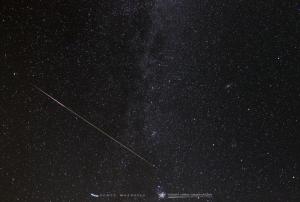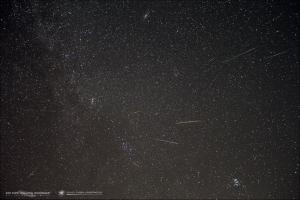2016 Perseids are Ready to Rock
Remember that amazing meteor shower that happens in August? That is the Perseid Meteor Shower and it started on July 17th, making now the time to plan where you will be for the August 12-13th shower peak. Meteor activity will continue to increase as we close in on the peak dates with bright meteors becoming very frequent overnight. Add in that the 2016 shower brings with it a nice up-tick in peak period meteor activity, and this year's shower is set to blow minds. All we need now is clear skies, late night stamina, and loads of enthusiasm to make for a stunning night of shooting stars.
The Perseid shower is a result of Earth passing through a debris field left behind by comet 109P/Swift-Tuttle. Discovered in 1862 by Lewis Swift and Horace Tuttle, comet 109P was identified as the source of the Perseid shower in 1865. The comet has a 133 year orbit around the Sun, making its last visit to the inner solar system in 1992.
Meteor showers are named after the constellation that their meteors appear to radiate from. This is called the "radiant point". The Perseid shower radiates from the constellation Perseus, visibly about half way between Perseus and Cassiopeia near the naked eye visible Perseus Double Cluster. Since Perseus is rising around sunset, the radiant point will be about 37º above the horizon at 1:00 a.m. on Friday, August 12th and rising higher over the course of the night, eventually passing overhead. This places the radiant point at an excellent place for viewing.
This year we are in for a delayed display of amazement, though when it kicks in, it will be awesome! The delay is because the bright gibbous Moon will be out to start on every night of the peak period. Friday morning and Saturday morning, which are the best times to view, will see the Moon set at 12:37 a.m. and 1:18 a.m. The bright Moon will out shine all but the brightest meteors until about 15 minutes after the Moon sets, which is when the shower will really kick in. We are also seeing a potentially significant increase in the number of meteors streaking overhead, an increase from our regular 80-100 meteors per hour to upwards of 200 meteors per hour! This is because the stream of comet debris we are passing through is particularly dense this year as a result of Jupiter’s gravity pushing particulates into larger groupings along the path Earth takes through the stream.
Viewing the Perseid show is simple pie if your are out after moonset. Grab a reclining lawn chair or a blanket and lay on your back looking towards the zenith (top of the sky). Since the Perseid radiant point is the top of the constellation Perseus, which will rise overhead from the Northeast, orientate your body so your feet are towards the Northeast. Meteors will be frequent and appear to originate from the radiant point.
Frosty Drew Observatory will open all night on Thursday, August 11th and Friday August 12th for the Perseid peak. Starting at sunset, we will offer views of Saturn's rings, and the Moon. Once 11:30 p.m. strikes, we will close the Observatory telescopes and make our way to the Observatory court yard where the Perseid shower will be taking off. We will stay on site until the pre-dawn Sun kicks us out. If weather is favorable, we will likely be on site overnight Saturday as well. During all nights, the Milky Way will be strikingly visible after the Moon sets with meteors shooting by. So stop in during the Perseid Meteor Shower peak and enjoy a fantastic night out under the stars with shooting stars blazing the sky.
-Scott
- Author:
- Scott MacNeill
- Entry Date:
- Jul 29, 2016
- Published Under:
- Scott MacNeill's Columns




